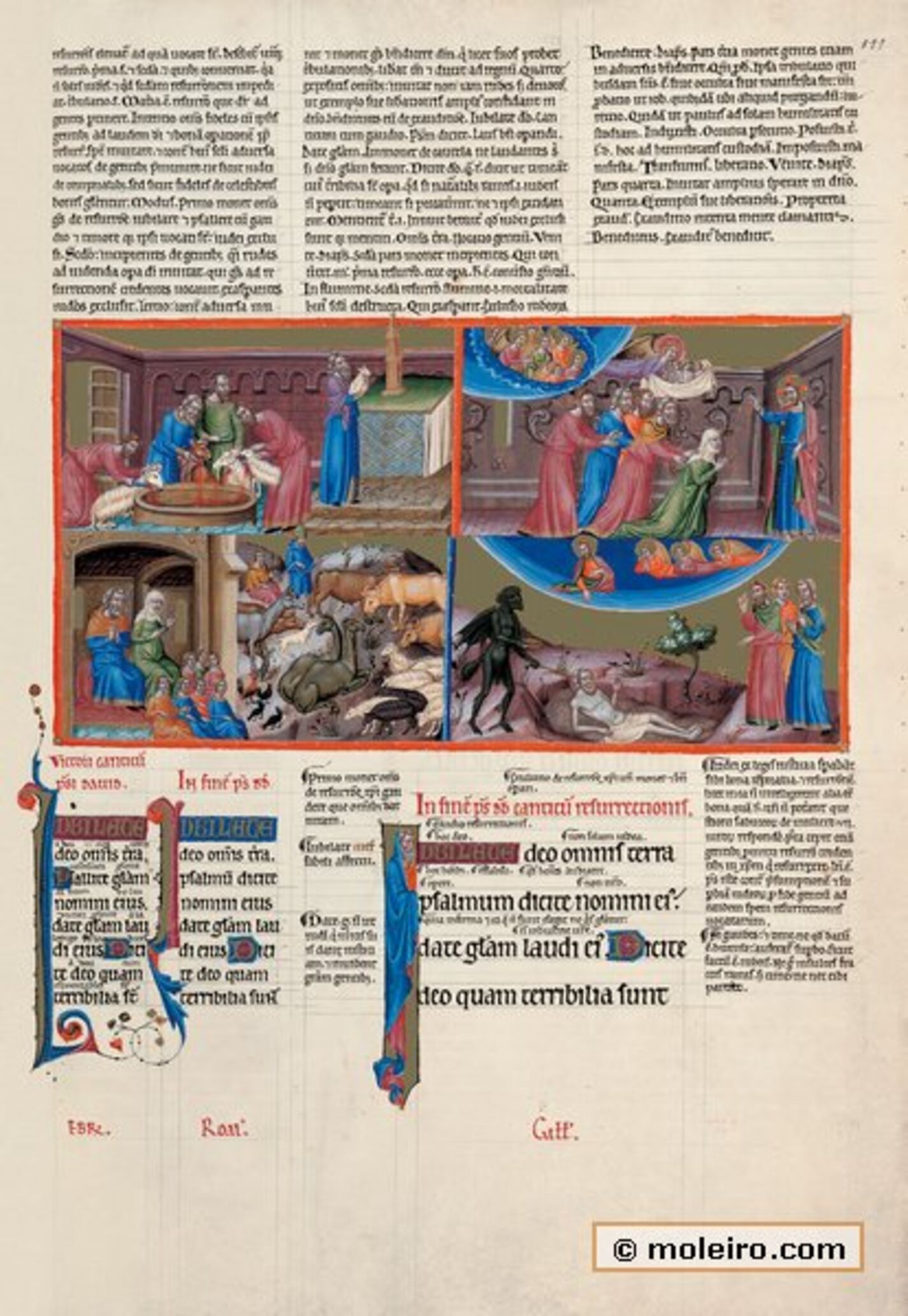The illustration of psalm 65, defined as a resurrection psalm (v. 1), consists of four scenes of virtually identical dimensions, three of which refer to the tale of Job. In the first image, at the top, several rams and a calf have their throats slit over a circular recipient collecting their blood. The indoor setting of the thanksgiving sacrifice also features an altar and tabernacle in front of which an old priest offers a lamb to God (v. 1, Jubilate Deo omnis terra // Shout with joy to God, all the earth). One of the celebrants, having finished his task, looks at the altar. The lower part depicts Job’s happy life, sitting with his wife and seven children including three daughters and watching the farm with all the animals belonging to Job and which he shares with his God. Not far away, two servants who seem to have been taken from a scene of the annunciation to the shepherds, complete the bucolic scene conveying the good position of the faithful leading character (Job 1: 1-4). The text refers to the sacrifices that Job, being a righteous and upright man, made occasionally in anticipation of the sins that his children might commit. This also explains the previous scene (v. 15, Holocausta medullata offeram tibi cum incenso arietum: offeram tibi boves cum hircis // I will offer up to thee holocausts full of marrow, with burnt offerings of rams: I will offer to thee bullocks with goats). The tale of Job is mentioned not in St Jerome’s commentary on psalm 65, but in his commentary on the following psalm (S. E. Hieronimus, Breviarium..., 1072).
The episodes in the right margin concern the salvation of the souls by Christ’s intercession. The adulterous woman is brought before him by scribes and Pharisees but Christ prevents her from being stoned by demanding that the first stone be cast by whoever is free of sin (Io 8: 1-11). The miniature devotes a surprising amount of space to angels. A winged creature uses a white cloth to gather up a group of naked souls awaited in heaven by a host of angels emerging in different poses from an oval opening to welcome the souls forgiven by Jesus. She is not stoned and perhaps the lamb in the old man’s hands in the first scene on the left is not sacrificed either.
Job is once again the subject of the bottom area when he undergoes the trials sent to him by God, ending his former happiness. Satan wounds Job with a malignant ulcer which Job resigns himself to (Job 2: 7-8). Three of his friends hear of his great misfortune and come to his aid but, failing to recognise him in his new condition, are surprised and astounded (Job 2: 11). The devil, alongside a half-naked Job, tries to break his will and make him hostile to his God but it is well known that he will not manage to do so. The psalm alludes to the Resurrection and the thanks given to God after hard times or a dangerous path. Job and the adulterous woman exemplify the calamities of all types that affect the chosen ones before their behaviour and ability to overcome God’s trials lead them to glory (v. 11, Induxisti non in laqueum, posuisti tribulationes in dorso notro: // Thou hast brought us into a net, thou hast laid afflictions on our back, and v. 12, ...Transivimus per ignem et quam: et eduxisti nos in refrigerium // We have passed through fire and water, and thou hast brought us out into a refreshment). God’s mercy plays an essential role in this process, implying the pardon of both the sinner (the adulterous woman) and the righteous (Job).
